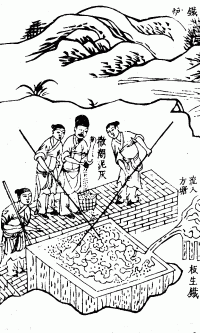حديد غفل
ساهم بشكل رئيسي في تحرير هذا المقال
|


الحديد الغفل (Pig iron )هو منتج وسيط لصهر خام الصلب مع فحم الكوك و مساعدات صهر ، أي ناتج اختزال خامات الحديد في الفرن اللافح. وللحديد الغفل محتوً عالٍ من الكربون, عادة بين 3.5 - 4.5%,[1] مما يجعله هشاً جداً وغير مفيد مباشرة كمادة إلا في استخدامات محدودة. ويسمى أيضا بتماسيح الحديد (لأنه يصب في قوالب تشبه التماسيح) أو الحديد الزهر. ولكن التسمية الأخيرة أوسع و تشمل سبائك أخرى تختلف عن الحديد الغفل.
The traditional shape of the molds used for these ingots was a branching structure formed in sand, with many individual ingots at right angles to a central channel or runner. Such a configuration is similar in appearance to a litter of piglets suckling on a sow. When the metal had cooled and hardened, the smaller ingots (the pigs) were simply broken from the much thinner runner (the sow), hence the name pig iron. As pig iron is intended for remelting, the uneven size of the ingots and inclusion of small amounts of sand was insignificant compared to the ease of casting and of handling.
The Chinese were making pig iron by the later Zhou Dynasty (1122 BC - 256 BC). In Europe, the process did not become common until the 14th century.
استعمالاته
Pig iron is typically poured directly out of the bottom of the blast furnace through a trough into a ladle car for transfer to the steel plant in liquid form, referred to as hot metal. The hot metal is then charged into a steelmaking vessel to produce steel, typically with an electric arc furnace or basic oxygen furnace, by burning off the excess carbon in a controlled fashion and adjusting the alloy composition. Earlier processes for this included the Bessemer process, open hearth furnace, finery forge, and the puddling furnace.